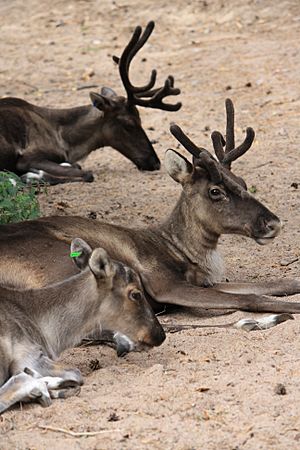Finnish forest reindeer facts for kids
Quick facts for kids Finnish forest reindeer |
|
|---|---|
 |
|
| Scientific classification |
|
| Kingdom: | Animalia |
| Phylum: | Chordata |
| Class: | Mammalia |
| Order: | Artiodactyla |
| Family: | Cervidae |
| Subfamily: | Capreolinae |
| Genus: | Rangifer |
| Species: | |
| Subspecies: |
R. t. fennicus
|
| Trinomial name | |
| Rangifer tarandus fennicus (Lönnberg, 1909)
|
|
The Finnish forest reindeer (Rangifer tarandus fennicus) (Finnish: metsäpeura, Russian: лесной северный олень), also known as European forest reindeer is a rare subspecies of the reindeer native to Finland and northwestern Russia. They are found primarily in Russian Karelia and the provinces of North Karelia, Savonia and Kainuu in Finland, though some range into central south Finland. They are distinct from the semi-domesticated mountain reindeer (Rangifer tarandus tarandus) in their larger size and preference for dense boreal forest habitat, where they are rarely seen by humans, over the open tundra. They migrate seasonally back and forth across the long Russo-Finnish border.
Contents
Size
The Finnish forest reindeer is one of the largest subspecies of reindeer. It is 180–220 cm long and the tail 10–15 cm. The adult male is larger, weighing 150–250 kg, while adult females weigh about 100 kg. Their longer legs, wide hooves and narrower V-shaped antlers facilitate movement through deep snow and wooded habitats.
Range and status
In the 17th century, the Finnish forest reindeer ranged throughout Finland and western Russia. Hunting, reindeer husbandry and habitat degradation through forestry led to their near complete extinction in Finland by the end of the 19th century. In 1700, in Russia the population was concentrated in Kandalaksha (Kantalahti) and Lake Onega (Äänisjärvi)) but hunting and reindeer farming wiped them out in that area as well. In 1979 to 1980 they were introduced from Kainuu, Finland to middle Finland to Salamajärvi National Park. A small population of some 1,000 also thrive in Southern Ostrobothnia. While their populations have been recovering in Finland, it has been suggested that an increasing, returning wolf population may be partially responsible for slowing the recovery.
In 2013 Finnish and Russian researchers began a collaborative comprehensive population study using telemetry tags, collars linked to satellites to track the populations of the rare and threatened Rangifer tarandus fennicus, which is found in eastern Finland and northwest Russia. The estimates for the Finland population ranges from 850 reindeer to up to 2,000 or 3,000.
According to a census carried out by helicopter in Finland's Kainuu region this year, the population there totals 793 individuals. There are roughly 1,000 in the Suomenselkä area, with a few dozen around the towns of Ähtäri and Lieksa. Miettunen says that levels have remained quite steady in recent years.
—Alaska Dispatch, 2013
The Finnish Ministry of the Environment considers the subspecies to be Near Threatened.
WildForestReindeerLIFE
The WildForestReindeerLIFE project in Finland started in 2016, lasting seven years. The project is coordinated by Wildlife Service Finland and co-funded by the LIFE Programme. One of its main goals is to reintroduce forest reindeer to its original habitats in Suomenselkä: National Parks of Lauhanvuori and Seitseminen were chosen as the reintroduction sites. The first animals were released in 2019.
The animals moved to Suomenselkä originate from Kainuu and Finnish zoos: Korkeasaari Zoo, Ähtäri Zoo and Ranua Zoo. Zoo employees also participate in planning the daily care of the animals living in the on-site enclosures, and provide wildlife veterinarian assistance.
Zoo population
There are about 150 Finnish forest reindeer in 25 European zoos. These animals have made the WildForestReindeerLIFE reintroduction project in Finland possible.
The Finnish forest reindeer has been part of European Association of Zoos and Aquaria (EAZA)'s population management plan since a studbook of the species was founded in 1998. From 2020, the species was added to the EAZA Ex-situ Programme (EEP). The programme coordinator works in Korkeasaari Zoo in Helsinki.
Comparison with other populations of woodland reindeer globally
The boreal woodland caribou of the subspecies Rangifer tarandus caribou in Canada, which are also forest-dwelling and avoid humans, are also experiencing a decline in populations and were designated as threatened in 2002 by the Committee on the Status of Endangered Wildlife in Canada (COSEWIC).

